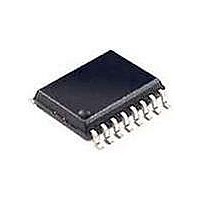SI2400-BSR Silicon Laboratories Inc, SI2400-BSR Datasheet - Page 25

SI2400-BSR
Manufacturer Part Number
SI2400-BSR
Description
Telecom Line Management ICs CONTACT SILICON LABS FOR AVAILABILITY
Manufacturer
Silicon Laboratories Inc
Type
Integrated Global DAAr
Datasheet
1.SI2400-BS.pdf
(94 pages)
Specifications of SI2400-BSR
Product
Modem Chip
Supply Voltage (min)
3 V
Supply Current
21 mA
Maximum Operating Temperature
+ 85 C
Minimum Operating Temperature
- 40 C
Mounting Style
SMD/SMT
Package / Case
SOIC-16
Lead Free Status / RoHS Status
Lead free / RoHS Compliant
5.12. Analog Codec
The Si2400 features an on-chip, voice quality codec.
The codec consists of a digital to analog converter
(DAC) and an analog to digital converter (ADC). The
sample rate for the codec is set to 9.6 kHz. When the
codec is powered on (SE4[1] [APO] = 1
the DAC is always present on the Si2400 AOUT pin.
When the codec is powered off (APO = 0
output is present on the AOUT pin instead. In order to
use the ADC, one of the four GPIO pins must be
selected as an analog input (AIN) by programming SE2
(GPIO).
Figure 10 shows the various signal routing modes for
the Si2400 voice codec, which are programmed through
register SE4[5:4] (DRT). Figure 10A shows the data
routing for data mode. This is the default mode used for
modem data formats. In this configuration, AOUT
produces a mixed sum of the DSPOUT and DSPIN
signals and is typically used for call progress monitoring
through an external speaker. The relative levels of the
DSPOUT and DSPIN signals that are output on the
AOUT pin can be set through SF4[1:0] (ATL) and
SF4[3:2] (ARL).
Figure 10B shows the format for sending analog voice
across the DAA to the PSTN. AIN is routed directly
across the DAA to the telephone line. In this
configuration, AOUT produces a mixed sum of the
DSPOUT and DSPIN signals. The relative levels of the
DSPOUT and DSPIN signals that are output on the
AOUT pin can be set through registers ATL and ARL.
The DSP may process these signals if it is not in PCM
data mode. Thus, the DSP may be used in this
configuration, for example, to decode DTMF tones. This
is the mode used with the “!0” and “A0” commands.
Figure 10C shows the loopback format, which can be
used for in-circuit testing.
Figure 10D shows the codec mode. This format is
useful, for example, in voice prompting, speaker
phones, or any systems involving digital signal
processing. In this mode, DSPOUT is routed to both the
AOUT pin and to the telephone line, and AIN is routed
directly to DSPIN.
In all the DRT formats, the DSP must be in PCM mode
in order to pass DSPIN and DSPOUT directly to and
from TXD and RXD.
b
), the output of
b
), a PWM
Rev. 1.3
5.13. V.23 Operation/V.23 Reversing
The Si2400 supports full V.23 operation including the
V.23 reversing procedure. V.23 operation is enabled by
setting S07 (MF1) = xx10xx00
S07[5] (V23R) = 1
75 bps and receive data at either 600 or 1200 bps. If
S07[4] (V23T) = 1
75 bps and transmit data at either 600 or 1200 bps.
S07[2] (BAUD) is the 1200 or 600 bps indicator.
BAUD = 1
at 1200 bps while BAUD = 0
operation.
When a V.23 connection is successfully established, the
modem will respond with a “c” character if the
connection is made with the modem transmitting at
1200/600 bps and receiving at 75 bps. The modem will
respond with a “v” character if a V.23 connection is
established with the modem transmitting at 75 bps and
receiving at 1200/600 bps.
The Si2400 supports the V.23 turnaround procedure.
This allows a modem that is transmitting at 75 bps to
initiate a “turnaround” procedure so that it can begin
transmitting data at 1200/600 bps and receiving data at
75 bps. The modem is defined as being in V.23 master
mode if it is transmitting at 75 bps and it is defined as
being in slave mode if the modem is transmitting at
1200/600 bps. The following paragraphs give a detailed
description of the V.23 turnaround procedure.
5.13.1. Modem in master mode
To perform a direct turnaround once a modem
connection is established, the master host goes into
online-command-mode
command (Escape pin activation, TIES, or ninth bit
escape) to the master modem. (Note that the host can
initiate a turnaround only if the Si2400 is the master.)
The host then sends the ATRO command to the Si2400
to initiate a V.23 turnaround and to go back to the online
(data) mode.
The Si2400 will then change its carrier frequency (from
390 Hz to 1300 Hz), and wait to detect a 390 Hz carrier
for 440 ms. If the modem detects more than 40 ms of a
390 Hz carrier in a time window of 440 ms, it will echo
the “c” response character. If the modem does not
detect more than 40 ms of a 390 Hz carrier in a time
window of 440 ms, it will hang up and echo the “N” (no
carrier) character as a response
b
will enable the 1200/600 V.23 channel to run
b
b
, then the Si2400 will receive data at
, then the Si2400 will transmit data at
by
b
sending
b
will enable 600 bps
or xx01xx10
Si2400
an
escape
b
. If
25












